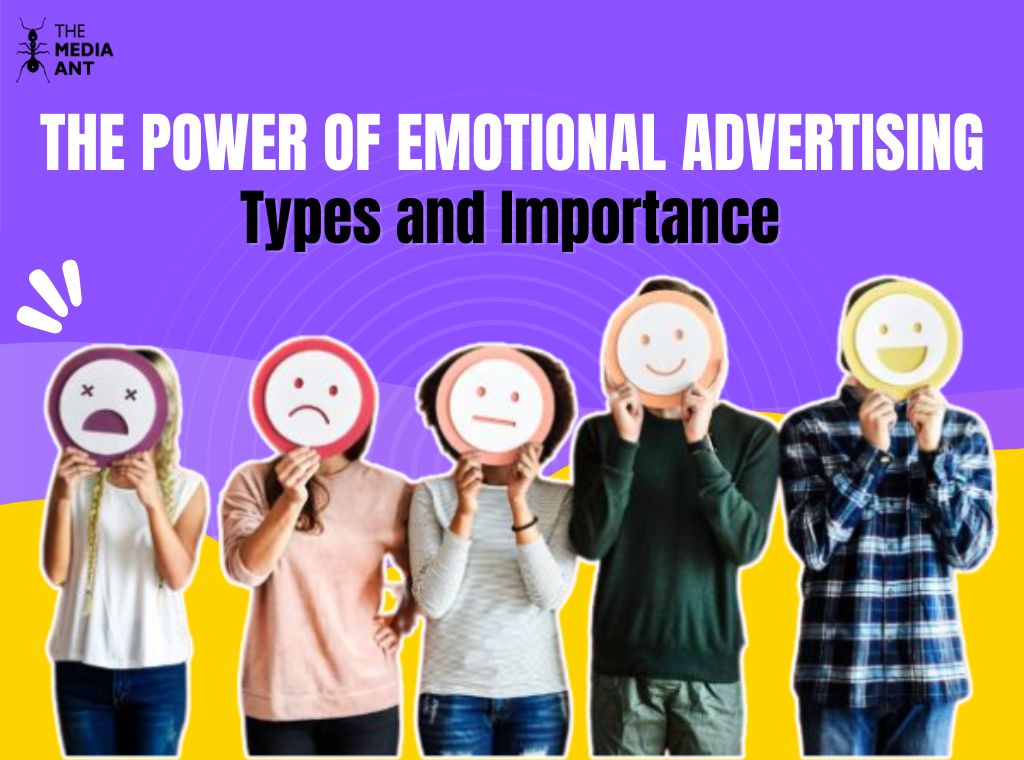What is Emotional Advertising?
Emotional advertising is a strategic approach used by marketers to tap into the feelings and emotions of consumers in order to create a deeper connection with their target audience. Unlike traditional advertising that focuses solely on product features or benefits, emotional advertising aims to evoke specific emotions such as happiness, sadness, excitement, or empathy. By crafting compelling narratives, using evocative imagery, and incorporating elements like music or storytelling, emotional advertising seeks to resonate with consumers on a personal level.
This form of advertising recognizes the power of emotions in influencing purchasing decisions and brand loyalty. Through emotional advertising, brands aim to not only capture attention but also create lasting impressions that drive consumer engagement and foster long-term relationships.
5 Types of Emotions in Advertising
1) Happiness and Joy
Leveraging positive emotions to create a sense of happiness and joy associated with the product or brand.
2) Fear and Anxiety
Utilizing fear-inducing scenarios to highlight a problem that the product or service can solve, prompting action or purchase to alleviate anxiety.
3) Sadness and Nostalgia
Eliciting feelings of sadness or nostalgia to create an emotional connection with consumers, often through sentimental storytelling or evocative imagery.
4) Surprise and Amazement
Generating surprise or amazement by showcasing unexpected features, benefits, or experiences associated with the product, sparking curiosity and interest.
5) Anger and Empowerment
Tapping into feelings of anger or frustration to mobilize consumers towards a cause or action, empowering them to make a change or support a particular brand or message.
Importance of Emotional Advertising
- Enhanced Brand Recall: Emotional advertising creates memorable experiences for consumers, leading to increased brand recall and recognition.
- Increased Consumer Engagement: Emotionally resonant ads capture attention and encourage consumers to engage with the brand, whether through sharing the ad or interacting with the brand’s content.
- Building Trust and Loyalty: Emotional connections foster trust and loyalty between the brand and its customers, as consumers are more likely to remain loyal to brands that they feel emotionally connected to.
- Influence on Decision Making: Emotions heavily influence consumer decision-making processes, and ads that evoke emotions can sway purchasing decisions in favor of the advertised brand.
- Differentiation in a Crowded Market: Emotional advertising helps brands stand out in a crowded marketplace by creating unique, authentic connections with consumers that competitors may struggle to replicate.
- Long-Term Relationship Building: By forging emotional connections, brands can establish long-term relationships with customers, leading to repeat purchases and advocacy.
- Positive Brand Perception: Emotionally resonant advertising can shape consumers’ perceptions of the brand, associating it with positive emotions and values.
- Humanizing the Brand: Emotional connections make brands more relatable and human, allowing consumers to connect with the brand on a personal level.
- Word-of-Mouth Marketing: Emotional ads are more likely to be shared by consumers with their friends and family, leading to organic word-of-mouth marketing and broader brand exposure.
- Impact on Customer Lifetime Value: Strong emotional connections can increase customer lifetime value by fostering ongoing engagement and loyalty, leading to sustained revenue growth for the brand.
Neuroscience Behind Emotional Advertising
The neuroscience behind emotional advertising involves understanding how the human brain processes and responds to emotional stimuli in advertising. Here’s a brief overview:
- Emotional Engagement: Emotional advertising activates regions of the brain associated with emotion processing, such as the amygdala and insula, leading to heightened engagement with the ad content.
- Memory Encoding: Emotional stimuli tend to be better remembered than neutral stimuli. Emotional advertising activates the hippocampus, a key brain region involved in memory formation, leading to stronger encoding of brand information and message recall.
- Attention Capture: Emotional advertising captures attention more effectively than rational or factual advertising. Emotional stimuli activate the brain’s attentional networks, directing focus towards the ad and increasing its impact.
- Decision Making: Emotions play a crucial role in decision-making processes. Emotional advertising influences the brain’s reward system, triggering positive associations with the brand or product and influencing purchase decisions.
- Mirror Neurons: Emotional advertising can activate mirror neurons in the brain, leading to a sense of empathy or resonance with characters or situations depicted in the ad, enhancing emotional connection and brand affinity.
- Neurochemical Responses: Emotional advertising can elicit neurochemical responses such as the release of dopamine (associated with pleasure and reward) or oxytocin (associated with trust and bonding), further strengthening the emotional connection with the brand.
- Implicit Associations: Emotional advertising can create implicit associations between the brand and specific emotions, shaping consumers’ perceptions and attitudes towards the brand over time.
Ethical Considerations in Emotional Advertising
When using emotional advertising, it’s important to follow ethical guidelines to protect and respect consumers. Here are the key points:
- Honesty and Authenticity: Emotional ads should truthfully represent the product or service. Avoid making false claims or exaggerating benefits.
- Informed Consent: Ensure that emotional ads do not exploit vulnerable groups like children or those with emotional issues. Consumers should make informed choices without being manipulated by fear or anxiety.
- Respect for Privacy: Advertisers must respect privacy rights and get consent before using personal data. Avoid using personal information without permission.
- Avoiding Harm: Emotional ads should not cause distress or harm. Be sensitive to cultural differences, trauma triggers, and the psychological effects of emotional content.
- Balanced Appeals: Emotional ads should balance emotional engagement with rational decision-making. Avoid manipulating emotions to the point where it overrides critical thinking.
- Social Responsibility: Advertisers should contribute positively to society by promoting values like diversity, inclusivity, and sustainability. Avoid reinforcing harmful stereotypes or unethical behaviors.
- Responsible Targeting: Avoid targeting emotional ads at vulnerable audiences, like children, people with mental health issues, or those in financial distress.
By following these guidelines, emotional advertising can be both effective and ethical, ensuring that consumer welfare and trust are maintained.
3 Best Examples of Emotional Advertising
Google – “Year in Search”

Google’s annual “Year in Search” commercials are renowned for their emotional impact. These ads typically compile significant events and moments from the past year, showcasing how people around the world have used Google to navigate through highs and lows. The emotional journey created by these ads often resonates deeply with viewers, tapping into feelings of nostalgia, empathy, and hope.
Nike – “Dream Crazy”

Nike’s “Dream Crazy” campaign featuring Colin Kaepernick is a prime example of emotional advertising. The ad addresses social issues like racial inequality and encourages viewers to pursue their dreams despite adversity. By aligning with Kaepernick’s story and the larger narrative of social justice, Nike effectively triggers emotions such as empowerment, inspiration, and solidarity among its audience.
P&G – “Thank You, Mom”

Procter & Gamble’s “Thank You, Mom” campaign is a series of commercials that run during major sporting events like the Olympics. These ads depict the journey of athletes from childhood to success and celebrate the unwavering support of their mothers throughout. The emotional impact lies in the portrayal of the sacrifices, love, and dedication of mothers, evoking feelings of gratitude, pride, and familial bonds among viewers.
FAQs on Emotional Advertising
How does emotional advertising differ from traditional advertising approaches?
Traditional advertising often focuses on rational appeals, highlighting product features and benefits. In contrast, emotional advertising prioritizes the emotional impact of the message, aiming to forge strong emotional connections with consumers rather than relying solely on logic and reason.
Why is emotional advertising effective in marketing campaigns?
Emotional advertising is effective because emotions play a significant role in consumer decision-making. Studies have shown that emotional responses can lead to increased brand recall, loyalty, and purchase intent. By tapping into consumers’ emotions, brands can create lasting impressions and foster stronger relationships with their audience.
How do marketers measure the success of emotional advertising campaigns?
Marketers measure the success of emotional advertising campaigns through various metrics, including brand awareness, brand sentiment, consumer engagement, and sales uplift. Additionally, qualitative methods such as surveys, focus groups, and sentiment analysis can provide insights into consumers’ emotional responses to the campaign.
What are some of the emotional marketing examples?
Emotional marketing examples include Google’s “Year in Search” campaign, Dove’s “Real Beauty” campaign, Nike’s “Dream Crazy” campaign featuring Colin Kaepernick, Always’ “Like a Girl” campaign, and Budweiser’s “Puppy Love” commercial.
What are the future trends and developments expected in emotional advertising?
Future trends in emotional advertising may include personalized and interactive experiences, leveraging technology such as augmented reality (AR) and virtual reality (VR) to immerse consumers in emotionally resonant narratives. Additionally, the integration of artificial intelligence (AI) and data analytics can enable more sophisticated emotional targeting and measurement capabilities.





